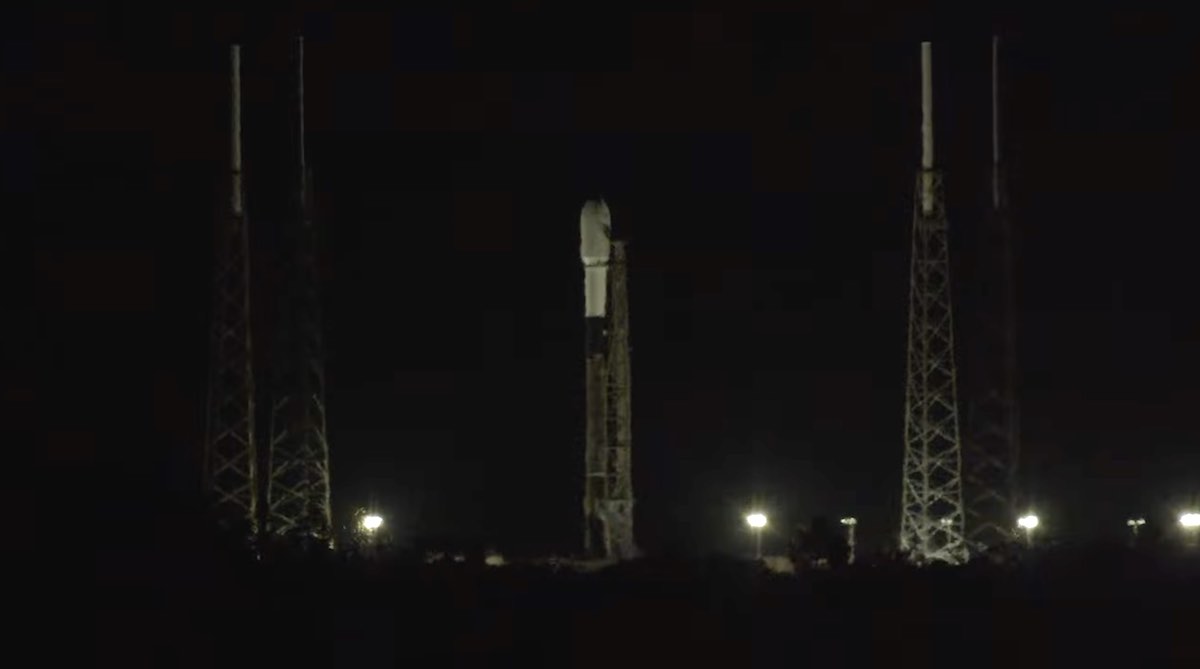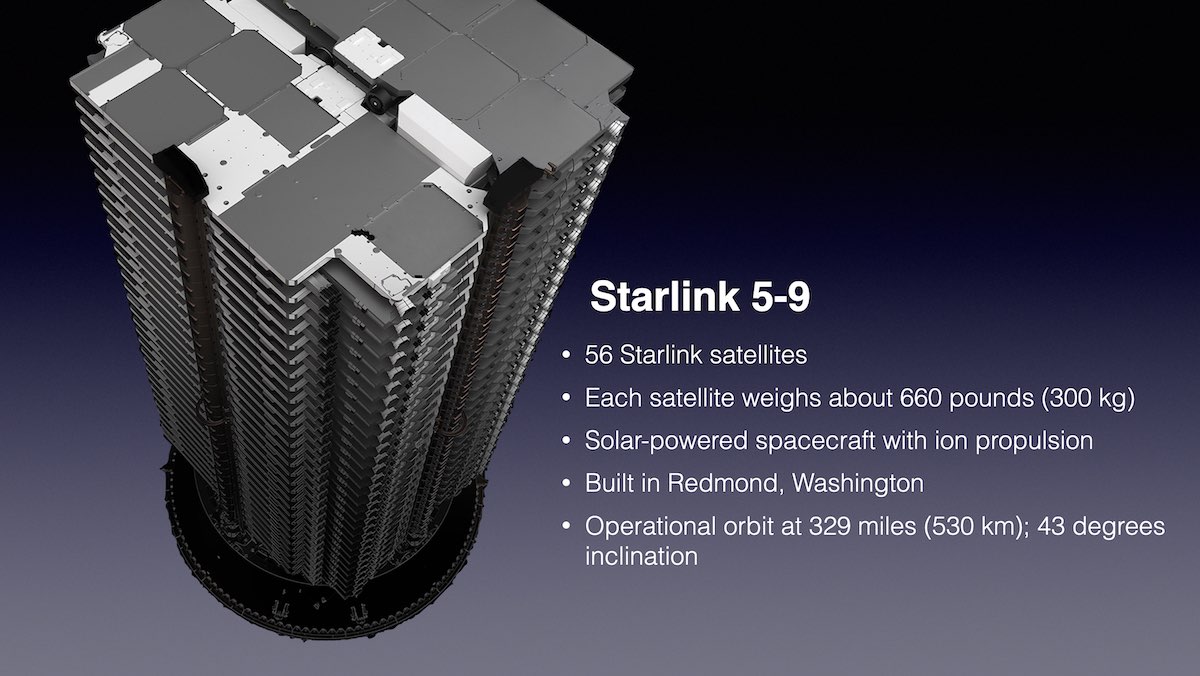Watch a our live coverage of the countdown and launch of a SpaceX Falcon 9 rocket on the Starlink 5-9 mission at 1:03 a.m. EDT (0503 UTC) on May 14 from Space Launch Complex 40 at Cape Canaveral Space Force Station, Florida. Follow us on Twitter.
SFN Live
Fifty-six more Starlink internet satellites are fastened atop a Falcon 9 rocket for liftoff early Sunday from Cape Canaveral on SpaceX’s 32nd launch of the year.
Forecasters predict a 95% chance of good weather for liftoff of the 229-foot-tall (70-meter) Falcon 9 rocket at 1:03:50 a.m. EDT (0503:50 UTC) from Pad 40 at Cape Canaveral Space Force Station. A little more than an hour later, the Falcon 9’s upper stage will release the 56 Starlink internet satellites into orbit a few hundred miles above Earth.
The mission is numbered Starlink 5-9 in SpaceX’s launch sequence. With Sunday’s launch, half of SpaceX’s 32 launches so far this year will have been flights primarily dedicated to the Starlink broadband network, which provides high-speed, low-latency connectivity to customers around the world.
The batch of 56 Starlink satellites will tie the record for the heaviest payload ever launched by a SpaceX rocket, matching the figure on four previous Falcon 9 missions with a full load of Starlink spacecraft. After the Starlink 5-9 launch, SpaceX will have sent 4,447 Starlink satellites into orbit
SpaceX currently has more than 4,000 functioning Starlink satellites in space, with more than 3,400 operational spacecraft and nearly 500 moving into their operational orbits, according to a tabulation by Jonathan McDowell, an expert tracker of spaceflight activity and an astronomer at the Harvard-Smithsonian Center for Astrophysics.
The rest of the Starlink satellites were prototypes or failed platforms that have been retired from service and guided back into the atmosphere to burn up on re-entry.
Sunday’s mission will continue deploying SpaceX’s older-generation Starlink V1.5 satellites, after two launches earlier this year started placing a new generation of Starlink satellites in orbit. The new satellites, known as the Starlink V2 Mini design, are larger and offer four times the broadband capacity of the older-design satellites.
The first 21 Starlink V2 Mini satellites launched Feb. 27 on a Falcon 9 rocket, but some of the satellites ran into problems after arriving in space. A few spacecraft in the first batch of Starlink V2 Mini satellites were de-orbited, and SpaceX has held back others from entering operational service. Some of the Starlink V2 Minis appear to be maneuvering to different positions in the Starlink constellation, presumably to begin commercial internet service, according to McDowell’s website.
The new Starlink V2 Minis carry upgraded phase array antennas and a more efficient, higher-thrust argon-fueled electric propulsion system. They also have two solar arrays, compared to a single extendable solar panel on each Starlink V1.5 spacecraft.

The Starlink V1.5 satellites on Sunday’s Starlink 5-9 mission are similar to the Starlink spacecraft SpaceX has launched over the last few years, but they headed into an orbital plane that is, at least in regulatory terms, part of SpaceX’s second-generation, or Gen2, network.
SpaceX began launching satellites into the Gen2 network in December, beginning the population of new orbital planes with older-design satellites until the larger Starlink spacecraft design is ready to take over entirely.
The Starlink V2 Mini satellites that SpaceX started launching in February represent an intermediate step between the smaller Starlink V1.5 spacecraft and the even larger full-size Starlink V2s, which SpaceX plans to deploy in orbit using the company’s new Starship mega-rocket.
The Starlink V2s will be capable of transmitting signals directly to cell phones. But with the Starship rocket still in its test flight phase, SpaceX began launching the Gen2 satellites on Falcon 9 rockets and developed the V2 Minis to fit on the company’s existing launch vehicles.
The Starship has nearly 10 times the payload lift capability of a Falcon 9 rocket, with greater volume for satellites, too.
The Federal Communications granted SpaceX approval Dec. 1 to launch up to 7,500 of its planned 29,988-spacecraft Starlink Gen2 constellation, which will spread out into slightly different orbits than the original Starlink fleet. The regulatory agency deferred a decision on the remaining satellites SpaceX proposed for Gen2.
Specifically, the FCC granted SpaceX authority to launch the initial block of 7,500 Starlink Gen2 satellites into orbits at 525, 530, and 535 kilometers, with inclinations of 53, 43, and 33 degrees, respectively, using Ku-band and Ka-band frequencies. The Starlink 5-9 mission Sunday will target the 43-degree inclination orbit in the Starlink Gen2 constellation.
The FCC previously authorized SpaceX to launch and operate roughly 4,400 first-generation Ka-band and Ku-band Starlink spacecraft that SpaceX has been launching since 2019. SpaceX is in the final stages of populating the first-generation Starlink network.
The Gen2 satellites could improve Starlink coverage over lower latitude regions, and help alleviate pressure on the network from growing consumer uptake. SpaceX says the network has more than 1 million active subscribers, mostly households in areas where conventional fiber connectivity is unavailable, unreliable, or expensive.

The first-generation Starlink network architecture includes satellites flying a few hundred miles up, orbiting at inclinations of 97.6 degrees, 70 degrees, 53.2 degrees, and 53.0 degrees to the equator. Last year, most of SpaceX’s Starlink launches have released satellites into Shell 4, at an inclination of 53.2 degrees, after the company largely completed launches into the first 53-degree inclination shell in 2021.
During Sunday’s overnight countdown, SpaceX’s launch team will be stationed inside a launch control center just south of Cape Canaveral Space Force Station to monitor key systems on the Falcon 9 rocket and at the launch pad. SpaceX will begin loading super-chilled, densified kerosene and liquid oxygen propellants into the Falcon 9 vehicle at T-minus 35 minutes.
Helium pressurant will also flow into the rocket in the last half-hour of the countdown. In the final seven minutes before liftoff, the Falcon 9’s Merlin main engines will be thermally conditioned for flight through a procedure known as “chilldown.” The Falcon 9’s guidance and range safety systems will also be configured for launch.
After liftoff, the Falcon 9 rocket will vector its 1.7 million pounds of thrust — produced by nine Merlin engines — to steer southeast over the Atlantic Ocean. The Falcon 9 rocket will exceed the speed of sound in about one minute, then shut down its nine main engines two-and-a-half minutes after liftoff. The booster stage will separate from the Falcon 9’s upper stage, then fire pulses from cold gas control thrusters and extend titanium grid fins to help steer the vehicle back into the atmosphere.
Two braking burns will slow the rocket for landing on the drone ship “Just Read the Instructions” around 410 miles (660 kilometers) downrange approximately eight-and-a-half minutes after liftoff. The reusable booster, designated B1067 in SpaceX’s inventory, will fly on its 11th trip to space Sunday.
The Falcon 9’s reusable payload fairing will jettison during the second stage burn. A recovery ship is also on station in the Atlantic to retrieve the two halves of the nose cone after they splash down under parachutes.
Landing of the first stage will occur just as the Falcon 9’s second stage engine cuts off to deliver the Starlink satellites into a preliminary parking orbit. Another upper stage burn 54 minutes into the mission reshaped the orbit ahead of payload separation.
Separation of the 56 Starlink spacecraft, built by SpaceX in Redmond, Washington, from the Falcon 9 rocket is scheduled nearly 65 minutes after liftoff.
The Falcon 9’s guidance computer aims to deploy the satellites into an orbit at an inclination of 43 degrees to the equator, with an altitude ranging between 185 miles and 211 miles (298-by-340 kilometers). After separating from the rocket, the 56 Starlink spacecraft will unfurl solar arrays and run through automated activation steps, then use their krypton-fueled ion engines to maneuver into their operational orbit 329 miles (530 kilometers) above Earth.
ROCKET: Falcon 9 (B1067.11)
PAYLOAD: 56 Starlink satellites (Starlink 5-9)
LAUNCH SITE: SLC-40, Cape Canaveral Space Force Station, Florida
LAUNCH DATE: May 14, 2023
LAUNCH TIME: 1:03:50 a.m. EDT (0503:50 GMT)
WEATHER FORECAST: 95% chance of acceptable weather; Low risk of upper level winds; Low risk of unfavorable conditions for booster recovery
BOOSTER RECOVERY: “A Shortfall of Gravitas” drone ship northeast of the Bahamas
LAUNCH AZIMUTH: Southeast
TARGET ORBIT: 185 miles by 211 miles (298 kilometers by 340 kilometers), 43.0 degrees inclination
LAUNCH TIMELINE:
- T+00:00: Liftoff
- T+01:12: Maximum aerodynamic pressure (Max-Q)
- T+02:28: First stage main engine cutoff (MECO)
- T+02:31: Stage separation
- T+02:38: Second stage engine ignition (SES 1)
- T+02:46: Fairing jettison
- T+06:13: First stage entry burn ignition (three engines)
- T+06:32: First stage entry burn cutoff
- T+08:08: First stage landing burn ignition (one engine)
- T+08:29: First stage landing
- T+08:36: Second stage engine cutoff (SECO 1)
- T+54:05: Second stage engine ignition (SES 2)
- T+54:07: Second stage engine cutoff (SECO 2)
- T+1:04:53: Starlink satellite separation
MISSION STATS:
- 223rd launch of a Falcon 9 rocket since 2010
- 234th launch of Falcon rocket family since 2006
- 11th launch of Falcon 9 booster B1067
- 165th flight of a reused Falcon booster
- 189th SpaceX launch from Florida’s Space Coast
- 124th Falcon 9 launch from pad 40
- 179th launch overall from pad 40
- 84th Falcon 9 launch primarily dedicated to Starlink network
- 29th Falcon 9 launch of 2023
- 32nd launch by SpaceX in 2023
- 23rd orbital launch attempt based out of Cape Canaveral in 2023
Email the author.
Follow Stephen Clark on Twitter: @StephenClark1.
from Spaceflight Now https://ift.tt/UHswfeq
via World Space Info







0 comments:
Post a Comment